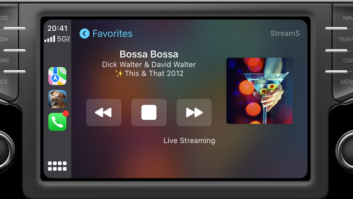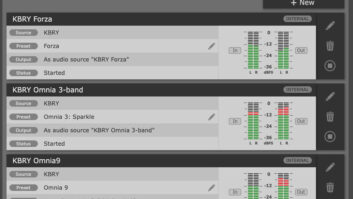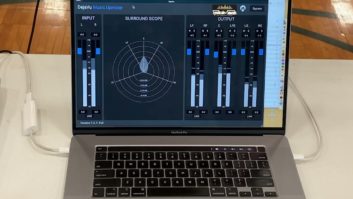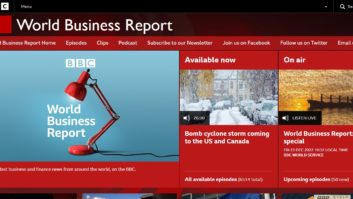Neural Exec Says Stations Need an Upgrade Path That Works With Existing Equipment and Content
—
Robert Reams, co-founder and chief technical officer of Neural Audio, responds here to an article by David Frerichs of Coding Technologies in the Dec. 1, 2004 issue.
This is one is a series of commentaries from companies adapting surround sound technology to radio.
First of all, I want to thank Mr. Frerichs for the time he has put into the promotion of 5.1. It is obvious that 5.1 is becoming an addition to the broadcaster’s cache of technologies.
There is still some confusion regarding Neural technologies. I want to briefly address such misconceptions (again) regarding Neural Audio’s spatial coding system for broadcast.
That being said, let’s address some of Mr. Frerich’s comments:
“Any successful surround sound technology for HD Radio needs to have the following
features: backward compatibility with existing radios (good for both single-program and multi-program stations) and scalability from ‘pseudo surround’ to true surround impact on radio stations. It must also be built with industry collaboration.”
There is nothing to disagree with here. Neural’s watermark approach achieves fully forward and backward compatibility and is scalable, when appropriate, to completely transparent recovery of the original content. In addition, Neural believes that “compatibility” includes analog and tandem coded paths.
As far as industry collaboration, Neural has been in public collaboration (on the broadcast side) with XM, Harris, NPR, Infinity, Clear Channel, Ibiquity and Coding Technologies for several years. Noted engineers and Tonmeisters have contributed heavily in this process. Power users such as Mike Pappas of KUVO, Jan Andrews of NPR and David Casey, formerly with Infinity Seattle and now with Neural, and a long list of contributors supply an endless stream of precious information from the field on how to improve this system.
“HDC Surround can achieve a single-stream 5.1 surround sound broadcast in a single HD Radio Main Audio Program.”
Yes it can. It cannot, however, function (with side information intact) within a real-world radio station infrastructure. The radio station will have to completely retool.
“The demo at the NAB Radio Show used an 80 kbps stereo core with 16 kbps of surround for a true surround experience.”
David, surely by now you understand the value of data to the broadcaster. Removing that much data from content that will never benefit from it is not a good value proposition for the broadcaster.
“… HDC Surround systems can be deployed into today’s digital radio stations without
requiring a complete overhaul. The last thing stations want to do is throw out all their existing equipment just to upgrade to 5.1 audio.”
There are two problems here.
The first problem is that Mr. Frerichs proposes that HDC Surround doesn’t require a complete overhaul. This is simply not true. How do you move the 5.1 around the plant? How do you edit it? What about analog mixers and stereo editors? How about stereo STLs? How about the server and automation system?
The second problem has to do with “upgrading to 5.1 audio.” Legacy stereo content is going to be with us in the foreseeable future. It’s not about upgrading, it’s about interoperability. Analog, digital, lossy, linear, stereo and 5.1 must co-exist within a unified operating system for the time being.
Don’t get me wrong, I think the newer technologies are fantastic, I just don’t think that analog, stereo and linear formats are going to suddenly evaporate. They must be contended with.
“This reality has been the primary driver of pseudo-surround technologies like matrix audio and watermark audio. While admittedly easier to deploy, their results are not the best and cannot scale up to provide a true surround experience.”
I challenge Mr. Frerichs to define the magical threshold where surround ceases to be “pseudo” and becomes “true.” While he’s at it he can change the word “easier” to “possible.”
Someday, broadcast stations, as we know them, may make the transition to all digital facilities employing a world standard format. Until then the Neural system is the only technology offering seamless, reliable and complete interoperability while meeting the consumer’s expectation of what is considered discrete 5.1 surround sound.
“Due to the stereo-mixdown nature of HDC Surround, stations can be HDC Surround-enabled through additions to the existing stereo chain, not a replacement of the entire system.”
I believe that Mr. Frerichs is referring to the radio station post-exciter. He can’t mean that downmixing by itself is an adequate method of getting 5.1 through the “entire system.” There is no explanation of how the side information is reliably transported through existing “pipes” which could be lossy, analog or just not correctly formatted.
This is why Neural rethought this approach years ago. Side information approaches yield good performance until the side information is gone. Watermark embedment, however, survives under the same scenarios because the spatial information is contained in the audio waveform. As NPR proved, the audio will fail before the watermark does.
“In the end, stations and equipment manufacturers need to decide whether they want the quick fix of a solution limited to matrix and watermark, or a long-lasting solution like HDC Surround which can also leverage the digital nature of HD Radio for maximum benefit.”
Referring to an enabling technology that is ready now as “limiting” while calling an unproductised technology “long lasting” is great marketing, but it’s not going to get the broadcaster on the air with 5.1. I do, however, agree that digital radio and 5.1 surround, together, makes sense.
In closing, I would challenge Mr. Frerichs to take a walk through a real-world radio station and observe its innermost workings. I entreat him to understand the flow of content from the many imperfect sources through the studios and audio mixing console in various stages of upgrade and into the servers and automation where it is played out through processing that may represent the very history of the station.
I think he will see that technology as applied to the radio station is that of continuous evolution. With the exception of formats, there is no sudden and gigantic change, there is but transition accomplished in thousands of tiny incremental but complementary stages. It is within this environment that we must invent and apply our technologies; to do otherwise is to fail the broadcast personnel who toil endlessly, daily, nightly to achieve the best possible value for their station without even a second of “dead air.”












